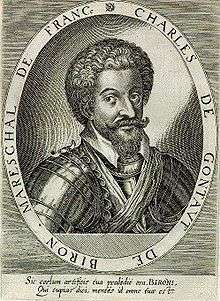Charles de Gontaut, duc de Biron

Charles de Gontaut, duc de Biron (1562 – 31 July 1602) was a French soldier whose military achievements were accompanied by plotting to dismember France and set himself up as ruler of an independent Burgundy.
Biography
He was born in Saint-Blancard. He was the son of Armand de Gontaut, baron de Biron, under whose command he fought for the royal party against the Catholic League in the later stages of the Wars of Religion in France. His efforts won him the name “Thunderbolt of France” (Latin: Fulmen Galliae). Henry IV made him admiral of France in 1592, and marshal in 1594. As governor of Burgundy in 1595, he took the towns of Beaune, Autun, Auxonne and Dijon, and distinguished himself at the battle of Fontaine-Française. In 1596 he was sent to fight the Spaniards in Flanders, Picardy, Artois and finally at the Siege of Amiens where he funded much of the Kings army.
After the peace of Vervins, he discharged a mission at Brussels in 1598. From that time, he was engaged in intrigues with Spain and Savoy aiming at the overthrow of the Bourbon dynasty, the dismemberment of the kingdom of France into provincial states, and his own elevation as sovereign of Burgundy. Notwithstanding these intrigues, he directed the expedition sent against the duke of Savoy (1599–1600). He fulfilled diplomatic missions for Henry in Switzerland (1600) and England (1601), the latter mission being to announce the marriage of Henry to Maria de' Medici.
While engaged in these duties, he was accused and convicted in his absence of high treason by the French Parlement. He was induced to come to Paris, where he was apprehended and then beheaded in the Bastille on 31 July 1602.
In literature
He was the inspiration behind the character Berowne in William Shakespeare's Love's Labour's Lost, which was written during his lifetime.[1] After his death, his tragic fate was dramatised by George Chapman in The Conspiracy and Tragedy of Charles, Duke of Byron (1608, republished in 1625 and 1653).
Notes
- ↑ G.R. Hibbard (editor), Love's Labour's Lost (Oxford University Press, 1990), p.49
References
 Chisholm, Hugh, ed. (1911). "Biron, Armand de Gontaut, Baron de, s.v. Charles de Gontaut". Encyclopædia Britannica. 3 (11th ed.). Cambridge University Press. p. 989.
Chisholm, Hugh, ed. (1911). "Biron, Armand de Gontaut, Baron de, s.v. Charles de Gontaut". Encyclopædia Britannica. 3 (11th ed.). Cambridge University Press. p. 989.  Gilman, D. C.; Thurston, H. T.; Colby, F. M., eds. (1905). "Biron, Charles de Gontault, Duke de". New International Encyclopedia (1st ed.). New York: Dodd, Mead.
Gilman, D. C.; Thurston, H. T.; Colby, F. M., eds. (1905). "Biron, Charles de Gontault, Duke de". New International Encyclopedia (1st ed.). New York: Dodd, Mead.